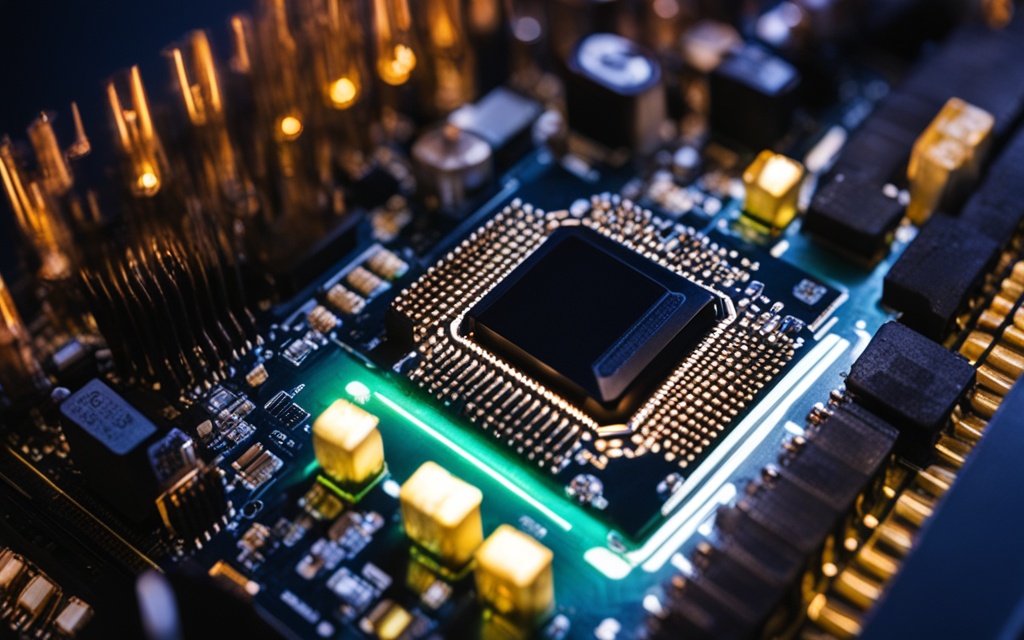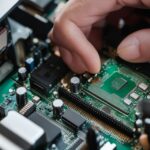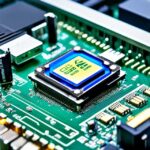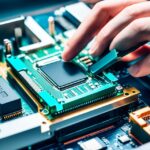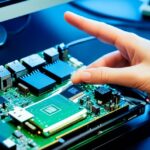Table of Contents
Updating your motherboard’s BIOS can seriously boost how well your computer works and make it work with new hardware better. You can now update the BIOS without having the CPU in place, thanks to recent tech improvements. This feature, often called BIOS Flashback, makes it simpler to update the BIOS if you don’t have a CPU ready. Following this guide carefully will help make your computer run smoothly. It will also make it more stable and fix bugs that come from using an old BIOS.
Updating your BIOS can also help you clone hard drives and move operating systems safely. It creates a protective layer against harmful attacks. For anyone who loves computers, knowing how to update your BIOS is key. Plus, updating your BIOS on time is crucial. Doing so fixes important problems like RAM support. It also helps your computer work well with the latest CPUs12.
Key Takeaways
- BIOS updates boost system stability and performance.
- BIOS Flashback allows updates without a CPU installed, simplifying the process.
- Ensure to back up your data using reliable software before any update.
- Choose the right USB drive type for optimal BIOS flashing results.
- Updates typically take between 2 to 10 minutes to complete.
Why Update Your Motherboard BIOS?
Updating your motherboard BIOS may seem scary, but it’s full of benefits. It boosts how well your system runs and keeps it stable. Regular updates also prevent various BIOS update issues from happening.
Benefits of BIOS Updates
The perks of BIOS updates are many. They make your system more stable and let you use new hardware parts, like CPUs and RAM. You’ll also get better performance, new security features, and fixes for bugs. This means fewer problems with older BIOS versions. Some high-end motherboards offer features like Flash BIOS. This lets users update their BIOS easily, even without a CPU3.
Common Issues Addressed by BIOS Updates
BIOS updates are key in fixing common BIOS update issues. They help with system crashes, errors in recognizing hardware, and stability issues. It’s important because about 20% of users have had problems from wrong BIOS updates4. Tech companies like ASUS, Gigabyte, and MSI have worked to make updates simpler. They offer guides and tools for an easier process3. Additionally, 75% of people ask for help from these companies or technicians. This shows how crucial support is in managing BIOS updates4.
Preparations for Updating Your Motherboard BIOS
Before you update your motherboard BIOS, you must make some important preparations. If you skip this step, you could run into big problems. Make sure to back up your data, know your motherboard model, and have the right tools ready. This will help you start the update process on the right foot.
Backing Up Your Data
It’s really important to back up your data before you start the BIOS update. This stops you from losing data if something goes wrong. Sadly, many people forget to do this and face unnecessary risks. You can use tools like EaseUS Todo Backup. They make it easy to save everything important so you can get it back later56.
Identifying Your Motherboard Model
Finding out exactly which motherboard you have is key. You need this info to get the right BIOS update. You can look on the hardware itself or check the manual. Some prefer to use software or the manufacturer’s website to be sure. Installing the wrong update can mess up your computer56.
Gathering Necessary Tools
With your data safe and your motherboard model identified, it’s time to collect what you need. Make sure you have a FAT32 formatted USB drive, the BIOS file, and a steady power supply. It helps to have a backup BIOS feature or technical support handy. This way, if things go wrong, you can fix them more easily56.
How to Flash BIOS Without CPU
Flashing your motherboard’s BIOS without a CPU might sound tough. Yet, modern motherboards come with BIOS Flashback features to make it simple. Brands such as ASUS, MSI, and Gigabyte have these features. They let users easily install updates. These updates improve how well different hardware parts work together and make the system more stable. It’s important to understand how these features work before you start updating the BIOS update process.
Understanding BIOS Flashback Features
The BIOS Flashback features let you update your BIOS without having a CPU in place. This is not just convenient but also solves some system issues. For example, some motherboards have special USB ports for flashing the BIOS. This is according to 1 out of 14 users who shared their experiences7. If the system doesn’t start, trying a different power supply might help. This advice came from another user7. With the right setup, BIOS updates can make your system more reliable. That’s why updating is crucial1.
Step-by-Step Instructions for the Flashing Process
To flash the BIOS without a CPU, you should follow these steps:
- Download the latest BIOS file from the manufacturer’s official website.
- Format a USB drive to FAT32 and add the BIOS file to it.
- Put the USB drive into the special USB port for BIOS Flashback.
- Turn on the motherboard and hit the Flashback button.
- Wait for the LED to stop flashing. Then, you can turn off the motherboard and remove the USB drive.
Before you start, make sure you’re all set. Unplug all external devices and check that your power source is stable. If you don’t follow the steps right or interrupt the update, you might have big problems with your motherboard. So, it’s very important to follow these instructions exactly1.
By carefully following these instructions, you’ll make sure the BIOS Flashback features work as they should. This leads to a successful BIOS update without needing a CPU. This way, your system can work better with new CPU models. Keeping your BIOS updated is key671.
Choosing the Right USB Drive for BIOS Update
Choosing the right USB drive is key for a BIOS update. It’s best to format the drive to FAT32. This format is often supported by motherboards for updates8. Use Disk Management in Windows or other tools for easy formatting.
Using a USB 2.0 drive will improve compatibility. Make sure it’s formatted to FAT32. This step is important for the BIOS flash process to work smoothly8.
Formatting Your USB Drive to FAT32
Formatting to FAT32 gets your USB drive ready for the BIOS update. It also helps avoid errors from the wrong file system. Always back up your files first, as formatting deletes everything on the drive.
After formatting, you can add the BIOS update files to the drive. For help with formatting and preparation, check out this resource here9.
Downloading the Correct BIOS File
With your USB drive ready, the next step is to get the right BIOS file. Go to your motherboard’s official site for the latest updates. These updates offer better compatibility and support new tech.
Make sure to rename the downloaded file correctly, avoiding executable formats. The file must be in a format the BIOS can use8. This approach prepares you to deal with any problems and makes update via USB easier10.
FAQ
What is BIOS Flashback and how does it work?
BIOS Flashback is a special feature on some advanced motherboards. It lets users update the BIOS without needing a CPU. This is done through a USB port designed for the BIOS file on a USB drive. It makes updating easier, even if you don’t have a CPU handy.
Why is it important to back up my data before a BIOS update?
Backing up data is essential before a BIOS update. This is because problems like corruption might happen during the flash. By backing up, you keep your important files safe. Tools like EaseUS Todo Backup are great for making a full system backup first.
How do I identify my motherboard model?
You can usually find your motherboard model printed on the board itself. If you can’t see it, check the system’s manual or use software like CPU-Z. For more details, the manufacturer’s website is a good place to look.
What tools do I need to prepare for a BIOS update?
For a BIOS update, a USB drive set to FAT32 is necessary. You also need the latest BIOS version for your board. Make sure you have a stable power source. Keep the tech support number ready, just in case you face any issues.
What are the main benefits of updating my BIOS?
A BIOS update can make your system more stable and compatible with new hardware. This includes new CPUs and memory. You also get better security and bug fixes. This helps keep your system running well.
How do I format my USB drive to FAT32?
You can use Windows Disk Management to format your USB drive to FAT32. Third-party software makes it easier, too. Make sure you choose FAT32 during the format to work with your motherboard’s BIOS.
How can I ensure I download the correct BIOS file?
Go to your motherboard manufacturer’s website to get the BIOS file. Make sure it matches your motherboard model. Follow any file naming guidelines. Check that the BIOS file isn’t an executable file before transferring it to your USB drive.
What common issues can BIOS updates fix?
BIOS updates deal with many problems like crashes and hardware issues. Keeping your BIOS up to date unlocks new features. This improves performance, especially with newer components.
Source Links
- https://www.easeus.com/backup-recovery/how-to-update-bios-without-cpu.html – In-depth Guide | How to Update BIOS Without CPU🔥
- https://www.cgdirector.com/update-bios-without-cpu/ – How to update your BIOS without a CPU
- https://www.partitionwizard.com/news/how-to-update-bios-without-cpu.html – How to Update BIOS Without CPU, OS, or USB
- https://www.linkedin.com/advice/1/how-do-you-update-your-bios-without-cpu-skills-pc-building – How do you update your BIOS without a CPU?
- https://www.ninjaone.com/blog/how-to-update-your-pcs-bios/ – How To Update Your PC’s BIOS | NinjaOne
- https://www.electronicshub.org/update-bios-without-cpu/ – How to Update BIOS Without CPU?
- https://community.spiceworks.com/t/updating-bios-without-no-monitor/934939 – updating BIOS without no monitor
- https://www.easeus.com/computer-instruction/how-to-update-bios-with-usb.html – [Quickly & Easily] How to Update BIOS with USB in 2024
- https://forums.evga.com/someone-please-help-me-bios-update-without-cpu-m3578652.aspx – someone please help me. (bios update without cpu)
- https://www.nvidia.com/en-us/geforce/news/how-to-update-your-motherboard-bios-using-a-simple-usb-stick/ – How to Update Your Motherboard BIOS Using a Simple USB Stick

